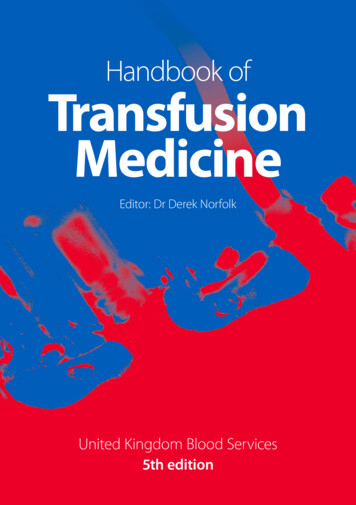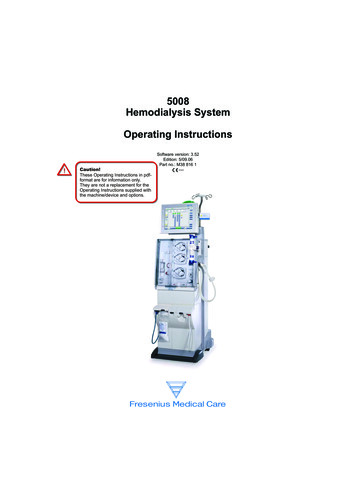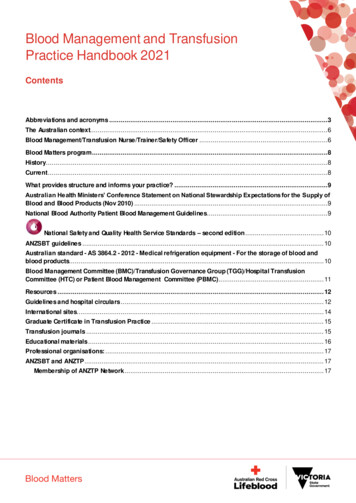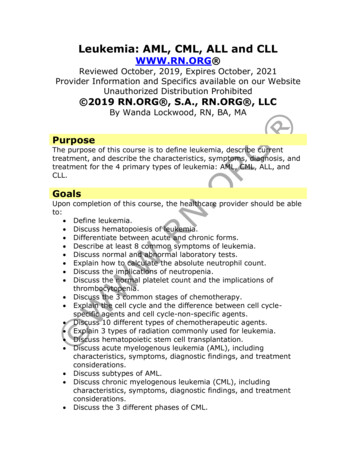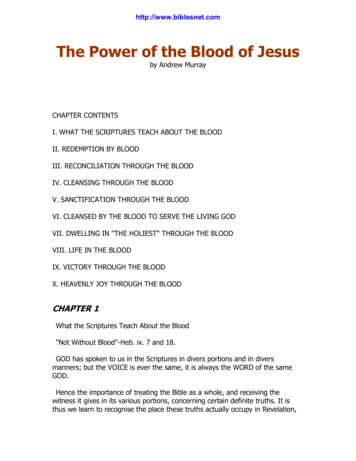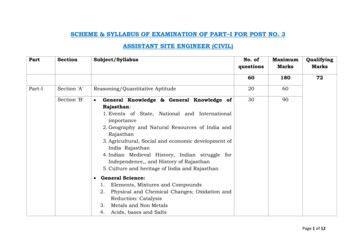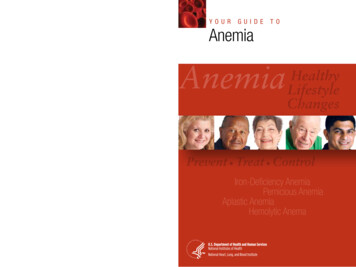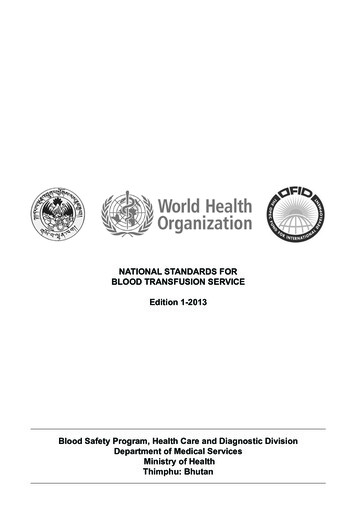
Transcription
NATIONAL STANDARDS FORBLOOD TRANSFUSION SERVICEEdition 1-2013Blood Safety Program, Health Care and Diagnostic DivisionDepartment of Medical ServicesMinistry of HealthThimphu: Bhutan
National Standards for Blood Transfusion Service2National Standards for Blood Transfusion Service/20132013
National Standards for Blood Transfusion ServiceFOREWORDMinistry of Health over a period of time has been focusing on consolidation ofhealth care services by improving quality, enhancing sustainability, improvingaccessibility and strengthening human resource development and deployment.Based on the principle of delivering quality health care services, the BloodSafety Program under the Department of Medical Services has developed amanual on “National Standards for Blood Transfusion Service” based on “GoodManufacturing Practices” (GMP) with objective to maintain and enhance thequality and safety of blood transfusion in the health facilities. The standardsaddress the entire low risk population; selection of donor, blood collection;testing/screening services, equipment, reagents, and human resources. Theefforts of the program are commended and appreciated since this standardhas come at a critical juncture where our efforts are geared towards providingquality health care services.Besides adhering to blood transfusion standards I would urge all health careproviders to make use of this and other clinical standards, guidelines, standardoperating procedures, handbook on universal precaution, etc., while deliveringservices to the clients. Your little bit of extra efforts will definitely go a longway in improving health care services to our people.Our quest is to improve quality of health care services to the people of Bhutan.I wish all health family members “TASHI DELEK” in our common endeavour.(DR. UGEN DOPHU)Director General1National Standards for Blood Transfusion Service/20132013
National Standards for Blood Transfusion Service2013PREFACEBlood transfusion is a life saving intervention that has an essential role in the total patientmanagement within health care delivery. It is therefore important that the health authoritytakes appropriate and adequate measures to ensure that the blood banks in the countryhave the basic requirements in terms of human and financial re-sources and the necessaryinfrastructure and other support to provide service in accordance with the set standards.For better adherence to the standards, special areas to focus on are self-sufficiency inblood and blood products, based on voluntary non-remunerated blood donation; continuedmedical education of all the health personnel involved in the blood transfusion chain;periodic auditing of blood banks and development of quality management system in theblood transfusion service.Keeping in mind the guiding principle of consistency, the manual on ‘National Standardsfor Blood Transfusion Service’ has been prepared on the basis of Good Laboratory Practiceand Good Manufacturing Practice, with the objective of ensuring quality and safety ofblood and blood products in the face of known and emerging threats to public health inthe country.The standards address the entire transfusion chain from donor to recipient, encompassingthe selection of blood donors from low-risk population, safe blood collection, testingof donated blood for transfusion transmissible infections and blood group serology,preparation, storage, issue and transportation of blood components for appropriate clinicaluse and lastly safe administration of blood to the recipients.In this document, the technical standards appear at the beginning followed by qualityrequirements for processes and procedures carried out in a center’s day to day operations.Some terms are specifically designed for the purpose of these standards. The term‘SHALL’ is used to indicate a mandatory statement and describes the single acceptableactivity or method.The term ‘SHOULD’ is used to indicate a commonly accepted activity which may havean effective alternative that can be used also.A glossary is included in the manual for the purpose of defining terms to reflect their usagein the context of these standards.2National Standards for Blood Transfusion Service/2013
National Standards for Blood Transfusion Service2013REFERENCESWhile preparing the document guidance has been taken from:1.Standards on Blood banks/Blood centers and Transfusion Services, 1st edition 2007,NABH, India2.WHO Recommendations on Basic Requirements for Blood Transfusion Services,WHO/EHT/06.05 advanced draft3.AABB Standards for Blood Banks and Transfusion Services, 21st edition4.Manual on the management, maintenance and use of the blood cold chain equipment,WHO, Geneva, 2005.5.‘Framework for standard of practice and service standards’ developed by QASD,Ministry of HealthDr Mahrukh Getshen,Transfusion Medicine Specialist,Blood Bank JDW, National Referral Hospital,Thimphu.3National Standards for Blood Transfusion Service/2013
National Standards for Blood Transfusion Service2013ACKNOWLEDGEMENTSBlood Safety Program, Ministry of Health would like to appreciate and thankthe valuable contributions and the hard work put in by the technical experts,laboratory specialists and personnel from the national, regional and district healthfacilities, health officials from Quality Assurance and Standardization Division,Drug Vaccine and Equipment Division in the ministry and also to officials fromBhutan Medical And Health Council and Drug Regulatory Authority.The Ministry of Health would like to specially acknowledge Dr Nani Nair, WHORepresentative, Country office, Bhutan, Dr Neelam Dhingra, Co-ordinator, BloodSafety, WHO/ Geneva, Dr Rajesh Bhatia, Director, Department of CommunicableDiseases, WHO/SEARO, and Dr Zarin Bharucha, WHO-Short Term Consultantfor providing valuable inputs.A special thanks to our financial partner OFID -OPEC Fund for InternationalDevelopment for supporting the printing of this publication.4National Standards for Blood Transfusion Service/2013
National Standards for Blood Transfusion ServiceTABLE OF CONTENTS2013PAGE NO.Glossary6-9Acronyms9-10Chapter 1Introduction12-13Chapter 2Code of ethics for blood donation and transfusion14-15Chapter 3The blood donor16-23Chapter 4Testing of donated blood24-25Chapter 5Blood and blood components26-27Chapter 6Clinical use of blood and blood component28-29Chapter 7Quality System30-39Chapter 8Waste management in blood transfusion service40-42Annexure5Process flowAnnex 1Donor questionnaire and consent formAnnex 2Donor deferralAnnex 3Blood request formAnnex 4Informed consent form for transfusion of blood & bloodcomponentsAnnex 5Blood transfusion reportAnnex 6Transfusion reaction formAnnex 7ATransfusion reaction investigation formAnnex 7BOrganogram of Blood Transfusion ServiceAnnex 8National Blood Transfusion CommitteeAnnex 9National Blood Transfusion ServiceAnnex 10National Blood CenterAnnex 11Regional Blood CenterAnnex 12Blood storage centerAnnex 13Standard tests at centersAnnex 14Basic equipment at centersAnnex 15Basic reagents at centersAnnex 16Equipment recordAnnex 17Standard Operating ProceduresAnnex 18Equipment specificationsAnnex 19Reagents specificationsAnnex 20National Standards for Blood Transfusion Service/2013
National Standards for Blood Transfusion Service2013GLOSSARYAutologous blood: The blood drawn from the patient/recipient for re-transfusion intohim /her at later date.Apheresis: Procedure whereby whole blood is separated by physical means intocomponents and one or more of them returned to the donor.Blood: Human blood drawn from a donor and mixed with anti-coagulant.Blood center: A facility or centre that performs all the following functions: Recruiting blood donors Screening and selecting blood donors Blood collection Testing, and processing of blood units Transportation, receiving, and storage of blood units Pre-transfusion tests on patients blood samples Issue of blood or blood components for clinical transfusionBlood storage center: A center that is involved in the following functions only: Receiving and storing screened blood and blood components from anotherauthorized blood establishment Performing compatibility tests Blood issue for transfusionBlood component: Any therapeutic constituent of blood that is separated by physical ormechanical means (e.g. red cells, platelets, plasma). It is not intended to capture plasmaderived products.Blood collection: A procedure whereby a single donation of blood is collected in ananticoagulant solution.Blood product: Any therapeutic substance derived from human blood, including wholeblood, blood components and plasma derived products.Calibrate: To set measurement of equipment against a known standard.Clinically Significant Antibody: Any allogenic or autologous antibody that is capable ofproducing a significant adverse reaction to transfused blood or component.Closed System: A system for collecting and processing blood in containers that havebeen connected together by the manufacturer before sterilization, so that there is nopossibility of bacterial or viral contamination from outside after collection of blood fromthe donor.6National Standards for Blood Transfusion Service/2013
National Standards for Blood Transfusion Service2013Corrective Action: An activity performed to eliminate the cause of an existingnonconformance, or other undesirable situation in order to prevent recurrence.Competence: Ability of an individual to perform a specific task according to standardprocedure.Conformance: Fulfillment of requirements as defined by standards.Critical: Capable of affecting quality.Document (noun): Written or electronically generated information involved in providinga product or service. Examples are policies, standards, standard operating procedures,work instructions, reports and records.Document (verb): To capture information for use in documents through writing orelectronic media.Donor: A person who gives whole blood or one of its components.Donor-Patient: A person whose blood or tissue is collected for possible autologoustransfusion or transplantation.Expiry: The last day on which blood, component, or tissue is considered suitable fortransfusion or transplantation.Equipment: A durable item, instrument or device used in a process or procedure.Evaluation: It is a specific selection process to determine the suitability of a procedure ormaterial (equipment, blood bags, or reagents).Guidelines: Documented recommendations.Good Laboratory Practice: Ensuring that laboratory functions are carried out inaccordance with requirements and may include planning, performance, monitoring,recording and reporting of laboratory functions.Good Manufacturing Practice: Ensuring that products are consistently produced andcontrolled in accordance with appropriate standards and regulatory requirements.Issue: To release for clinical use /transfusion.Internal Quality Control: Testing that’s routinely performed on material and equipmentto ensure their proper function.Label: An inscription affixed to a unit of blood, component or sample for identification.Labeling: Information that is required or selected to accompany a unit of blood,7National Standards for Blood Transfusion Service/2013
National Standards for Blood Transfusion Service2013component or sample, which may include content, identification, and description ofprocess, storage requirements, expiration date, cautionary, or indication for use.Maintain: To keep in the current state.Material: A good or supply item used in manufacturing process. Materials are a type ofinput product. Reagents are a type of material.Neonates: A young child less than 4 months of age.Organization: An institution, or part thereof that has its own functions and administration.Open System: A system, the contents of which are exposed to air and outside elementsduring preparation and separation of components.Policy: A written statement which guides present and future decisions. It determines thefuture course of action to be established.Process: A set of related task and activities, often performed by one person according toinstruction.Processing of blood: Any procedure that takes place after the blood is collected.Process Control: The efforts to standardized and control process in order to producepredictable out-put.Procedure: A series of task usually performed by one person according to instructions.Pre-donation procedure: It includes mandatory process and activity done before proceedingwith bleeding a donor.Post-donation procedures: All procedures and activities done after bleeding a donor.Preventive action: An action taken to reduce the potential for an error to occur.Product: A tangible result of a process.Quality: Characteristics of a unit of blood, component, sample, or service that bear on itsability to meet requirements. Fit for its purpose.Quality System: The organizational structure, responsibilities, policies, processes,procedures, and resources established by executive management to achieve quality.Quarantine: To isolate nonconforming blood, component or materials.Reaction: In reference to a transfusion, a suspected or proven, unexpected response to ablood transfusion, manifested by signs and/or symptoms.8National Standards for Blood Transfusion Service/2013
National Standards for Blood Transfusion Service2013Reagent: A substance used to perform an analytical procedure. A substance used (as indetecting or measuring a component or preparing a product) because of is biological orchemical activity.Replacement /family donation: donation given by an individual who gives blood when itis required by a member of the patient’s family or community. This may involve a hiddenpaid donation system in which the donor is paid by the patient’s family.Service: An intangible result of a process or procedure.Shall: A term used to indicate a requirement.Supplier: Individual or organization that provides an input material or service.Supplier Qualification: An evaluation method designed to ensure that input materialsand services (e.g., materials, blood component, patient blood sample) obtained from asupplier meet specified requirement.Traceability: The ability to follow all steps of a process or procedure from the beginningto end.Unit: A container of blood or one of its components in a suitable volume of anticoagulantobtained from a collection of blood from one donor.Urticarial Reaction: The development of hives, maculopapular rash, or similar allergicmanifestation.Validation: Establishing recorded evidence that proves a high degree of assurance thata specific process will consistently produce an outcome meeting its predeterminedspecification and quality attributes.Verification: Evaluating the performance of a system with regard to its effectivenessbased on intended use.Voluntary non-remunerated donation: Donation is considered voluntary and nonremunerated if the person gives blood, plasma or cellular components of his / her ownfree will and receives no payment for it, either in cash or kind which could be considereda substitute for money. Small tokens, refreshments are compatible with voluntary, nonremunerated donation.”Whole blood: Blood collected in an anticoagulant solution with or without additives.9National Standards for Blood Transfusion Service/2013
National Standards for Blood Transfusion ServiceACRONYMSAIDS:Acquired Immunodeficiency SyndromeBC:Blood CentreBMB:Bhutan Medicines BoardBMHC:Bhutan Medical and Health CouncilCPDA:Citrate Phosphate Dextrose AdeninineCCC:Coombs Control CellsDMS:Department of Medical ServicesDoPH:Department of Public HealthDRA:Drug Regulatory AuthorityDVED:Drugs Vaccine and Equipment DivisionELISA:Enzyme Linked Immuno-AssayEQAS:External Quality Assessment SchemeFFP:Fresh Frozen PlasmaGSH:Group Screen and HoldHb%:HemoglobinHBsAg:Hepatitis B Surface AntigenHBV:Hepatitis B VirusHCV:Hepatitis C VirusHIV:Human Immunodeficiency VirusHR:Human ResourceIAT:Indirect Antiglobulin testIEQAS:International external quality assessment schemeIQC:Internal Quality ControlMT:Medical Technologist10National Standards for Blood Transfusion Service/20132013
National Standards for Blood Transfusion ServiceMLT:Medical laboratory technicianMoH:Ministry of HealthNEQAS:National External Quality Assessment SchemeNBTC:National Blood Transfusion CommitteeNBTS:National Blood Transfusion ServiceNBC:National Blood CenterOFID:OPEC Fund for International DevelopmentPHL:Public Health LaboratoryPRC:Packed Red CellPC:Platelet ConcentrateQA:Quality AssuranceQM:Quality ManagerQS:Quality SystemRBC:Regional Blood CentreRGoB:Royal Government of BhutanSOP:Standard Operative ProcedureTPHA:Treponema Pallidum HemagglutinationTTI:Transfusion Transmissible InfectionsVBD:Voluntary Blood DonationVCT:Voluntary Counseling and TestingVNRBD:Voluntary Non-remunerated Blood DonorsWHO:World Health OrganizationWB:Whole Blood11National Standards for Blood Transfusion Service/20132013
National Standards for Blood Transfusion Service2013Chapter 1: INTRODUCTIONBlood transfusion is a key component of modern day health care and therefore it is ofutmost importance to ensure that blood and blood products meet the appropriate nationalstandards of safety and efficacy for transfusion and benefit blood recipients in their clinicalmanagement process.National Blood Policy, 2007Mission Statement:1. Ensure adequate, timely and easily accessible supply of safe and quality blood andblood products through the establishment of a National Blood Transfusion Service(NBTS).2. Ensure adequate resources for the operation of a sustainable National Blood SafetyProgram.3. Develop effective legislation and a national regulatory body to oversee the operationof the blood service in the country.4. Blood transfusions shall be advised and carried out under the supervision of aregistered medical practitioner or other suitably qualified and authorized health careprofessionalPresent scenario and future plansThe blood supply system in the country functions as part of the laboratory service inall the hospitals and BHU-I, whereby the individual hospital blood bank is obligedand responsible to undertake the task of recruitment of blood donors, blood collection,screening of blood units for infections, storage and making it available for trans-fusionto the respective clinical departments of the hospital. Such a fragmented organizationalstructure poses many challenges and constraints.Therefore, in line with the blood policy and the vision, national blood safety programhas proposed consolidation of the service in its medium to long-term strategic plan. Inthis proposal, critical functions like donor recruitment, blood collection, screening fortransfusion transmitted infections (TTIs), processing and distribution shall be limited tofew strategic blood banks that shall be referred to as ‘blood centers’ in each region; rest ofthe blood banks shall function as ‘blood storage centers’ and the service to be collectivelytermed as ‘Blood Transfusion Service’ (BTS).Hence, this document reflects the minimum requirements, the service and quality standardsbased on the new organizational and functional structure of BTS in line with the proposedconsolidation strategy.12National Standards for Blood Transfusion Service/2013
National Standards for Blood Transfusion Service2013Vision:To have a well organized, coordinated, standardized and quality national blood transfusionservice that ensures adequate, safe and timely blood supply to all the health facilitiespracticing clinical blood transfusions.Goals:1. To provide the best possible care to the donor before, during and after donation.2. To ensure that the best rational use of the donated blood is made by the prescribers.3. To implement quality management system in the service.13National Standards for Blood Transfusion Service/2013
National Standards for Blood Transfusion Service2013Chapter 2: CODE OF ETHICS FOR BLOOD DONATION AND TRANSFUSIONBlood transfusion service and hospital transfusion practice established by national healthauthority shall function in compliance with the below mentioned code of ethics.Blood donors and blood donation:2.1All matters related to blood donation should be in accordance with the NationalBlood Policy 2007.2.2Blood donation shall be on a voluntary basis and no-remuneration shall be givento the donors.There shall be no compulsion made on an individual to donate blood.2.3The donor should understand the risks of donating infected blood to others and his/her ethical responsibility to the recipient.2.4The donor should provide informed consent to the donation of blood and to thesubsequent use of the blood by the transfusion service.2.5Blood donation shall be based on the donor selection criteria laid down and mustnot entail discrimination of any kind including gender, nationality or religion.BTS personnel:2.6The BTS personnel shall explain the donor of the risks connected with the donationprocedure. The donor’s health and safety shall be the ethical responsibility of thestaff.2.7Blood should be collected under the overall responsibility of either a registeredmedical practitioner or an authorized BTS personnel who can manage a donoradverse reaction.2.8Anonymity between the donor and the recipient must be ensured and theconfidentiality of donor information assured.2.9Blood is a public resource and access should not be restricted. Wastage of bloodand blood components should be avoided at all times.2.10A profit motive shall not be the basis for the establishment and running of futureprivate blood banks or blood service in the country.14National Standards for Blood Transfusion Service/2013
National Standards for Blood Transfusion Service2013Hospital transfusion practice:2.11There should be no financial incentive, or motive of personal gain nor any coercionfrom the patient’s party to prescribe a blood transfusion. Rational clinical needsshould be the basis of prescribing blood transfusion.2.12The prescribing clinician shall inform the patient of known risks and benefits ofblood transfusion and of alternative therapies. The patient’s decision to accept orrefuse the procedure must be respected.2.13In the event that the patient is unable to give prior informed consent or in case of aminor, the clinician shall discuss with the patient’s family and decide to transfuseblood in the best interest of the patient.2.14Transfusion therapy must be carried out under the overall responsibility ofa registered medical practitioner or other qualified and authorized health careprofessional.2.15As far as possible only those components (cells, plasma or plasma derivatives)shall be prescribed that are need based, clinically appropriate and provide optimalsafety to the patient.15National Standards for Blood Transfusion Service/2013
National Standards for Blood Transfusion Service2013Chapter 3: THE BLOOD DONOR3.13.1.1Donor recruitment:All blood establishments in the country shall collect blood from voluntary, nonremunerated donors recruited from low risk, safe and healthy population withinthe community. No payments shall be made to any donor.3.1.2Pre-donation information shall be provided. Basic information on following topicsshall be included: Blood science. Importance of voluntary blood donation. General information about blood donation process and pre and post-donationcare. Importance of honest answers during the donor interview procedure. The tests conducted on donor and donated unit. HIV transmission and HIV risk reduction.3.1.3Pre-donation counseling shall be provided to all potential donors by authorizedstaff in a private and confidential manner.It shall include information on: High risk behaviors and mode of transmission of infections like HIV andhepatitis. Signs and symptoms of HIV/AIDS, hepatitis and other sexual transmittedinfections. Importance of true answers and self exclusion or self deferral by unsuitabledonors. Mandatory tests done on all donated blood. Confidentiality of test results. Obtaining an ‘Informed Consent’. Available testing options or sites for HIV test.3.23.2.1Donor selectionAll potential blood donors shall be assessed before blood donation by authorizedBTS personnel Assessment of blood donors shall include the following steps:a. Donor interview. Refer to Annex 2 for ‘Donor questionnaire and consent form’.b. Physical examination for any jaundice, swollen glands, skin rashes, tattoos,needle or body piercing marks.c. Check for body weight, temperature, and blood pressure.d. Check for hemoglobin content and ABO/Rh blood group.The interviewer then decides on the fitness of the donor based on the national donorselection criteria.16National Standards for Blood Transfusion Service/2013
National Standards for Blood Transfusion Service20133.2.2Criteria for blood donor acceptance:3.2.2.1 The donor shall be in the age group of 16 to 60 years.For 16 or 17 aged individuals, a written consent from parents / guardians shouldbe obtained before blood donation. Elderly donors between 60- 65 age groupmust be assessed by a doctor for suitability to donate.3.2.2.2 Minimum acceptable body weight shall be 45 kg for 350ml and 50 kg for 450mlblood collection. In an case, blood volume collected should not exceed 10ml/kg body weight.3.2.2.3 Minimum hemoglobin level must be 12.0 gm%3.2.2.4 Blood pressure: -Systolic reading between 90 mmHg and 180mmHg- Diastolic reading between 50 mmHg and 100mmHg3.2.2.5 The donor shall be having normal body temperature on the day of donation3.2.2.6 The donor shall be free from any skin disease at the phlebotomy site on the arm.3.2.2.7 The last blood donation must be at least three months ago.3.2.2.8 The donor shall be in good health and mentally alert on the day of donation.3.2.2.9 The donor shall not be a jail inmate or a drug/ alcohol addict.3.2.2.10 The donor should have eaten something in the last 8 hours and had 5 hours sleep.3.3Donor DeferralDonors shall be deferred based on national donor deferral guidelines. Refer to Annex 3.3.3.1 The following individuals must not be allowed to donate blood as they are at riskof contractingHIV/AIDS, Hepatitis B, Hepatitis C or syphilis due to their risky lifestyles:a. Intravenous drug users or individuals sharing sharp injectable objects.b. Persons with multiple sex partners.c. Commercial sex workers.d. Persons who had paid, casual or unsafe sex.e. Individuals with homosexual behaviors.f. Sex partners of all the above.3.3.23.43.4.117The following steps shall be followed when a donor is not accepted for donation:a. The donor shall be explained in a clear and understandable language thereason for deferral.b. The donor shall be informed whether the deferral is temporary or permanent. Iftemporary, encourage the donor to come after the deferral period is completed.c. The donor shall be referred to a doctor for consultation if required.d. All records of deferred donors shall be maintained.e. Reassure the donors and encourage them to ask questions or clarify any doubtsbefore they leave the blood center.Blood collection/donor phlebotomy procedureThis procedure shall be conducted by only trained and authorized personnel.National Standards for Blood Transfusion Service/2013
National Standards for Blood Transfusion Service20133.4.2Donor identification and blood unit identification must be confirmed before bloodcollection3.4.3Each blood unit shall be assigned a unique unit number which shall be used as anidentifier on all blood components, blood samples and for documentation purpose. For donations from voluntary blood donors, the alphabet letter ‘V’ shall beprefixed to the unit number. For donations from replacement blood donors, the alphabet letter ‘R’ shall beprefixed to the unit number. For donations collected at mobile sites, the alphabet letter ‘M’ shall beprefixed to the unit number. Donor’s name shall not appear anywhere on the blood bag.3.4.4 Equipment/supplies for phlebotomy3.4.4.1 Blood bags fulfilling the standard specifications shall be used for blood collection.All blood bags and sample collection tubes shall be checked before use for sterility,expiry date, appearance of the anti-coagulant solution, any leakage or any defectsin the bags.3.4.4.2 Quality control of all blood collection equipment shall be carried out as per thestandard operating procedures and documented.3.4.5Preparation of the veni-puncture site:The veni-puncture site shall be cleaned and prepared with locally available antiseptic agent to minimize risk of bacterial contamination.3.4.6Veni-punctureSuccessful veni-puncture must be carried out at first attempt. If the first venipuncture fails, a second veni-puncture shall be attempted only if the donor permits.In some cases a new blood bag may have to be used.3.4.7Anti-coagulantCPDA1 shall be the anticoagulant used in the blood bag. The volume of anticoagulant shall be in the proportion of 1:7 to the volume of blood collected foradequate anticoagulation.3.4.8Blood collection timeTotal blood collection time should be between 8 to 12 minutes. If the time exceeds12 minutes, the blood collected shall not be used for platelet preparation.3.4.9 Pilot samples3.4.9.1 Pilot samples are blood donor samples collected at the time of donation forconducting laboratory tests.3.4.9.2 Pilot samples shall be taken when the needle is in-situ and not from the blood bag.18National Standards for Blood Transfusion Service/2013
National Standards for Blood Transfusion Service20133ml of blood shall be collected in EDTA tube and 6ml in plain tube.3.4.9.3 The tubes containing pilot samples shall be appropriately labeled immediatelyafter blood collection.3.4.9.4 Hermetic sealing of the blood bag tubing shall be done to ensure sterility of theblood collected.3.4.10 Blood volume collected:a. 350ml in single bags for whole blood transfusion.b. 450ml in double or triple bags for preparation of packed red cells, freshfrozen plasma and platelet concentrates.3.4.11 Ther
Manual on the management, maintenance and use of the blood cold chain equipment, WHO, Geneva, 2005. 5. ‘Framework for standard of practice and service standards’ developed by QASD, Ministry of He
